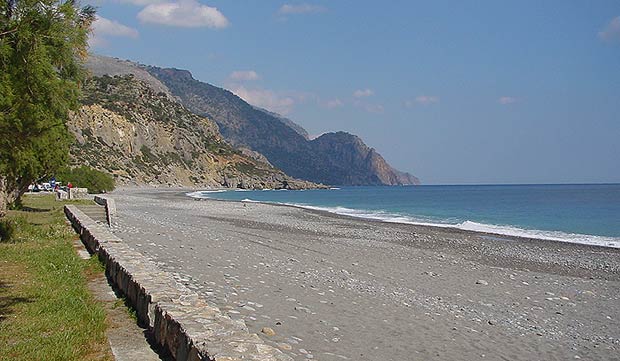Transfer to Sougia
Sougia is located at the end of a long valley in the south-west of Crete, about 75 km from the city of Hania. This scenic road goes up to the pass of Agia Irini and back down to sea level and is therefore quite a winding road. It takes just under two hours to cover that distance by car.
The small village of Sougia in the south-west of Crete has managed to remain unaffected by the growth of tourism in Crete. It is still a peaceful haven, with a long beach, plenty of good accommodation, and excellent places to eat, all at prices below those found in most of the island.
From early April to late October Sougia attracts visitors looking for a relaxing holiday away from mass-tourism. Whilst you can chose to do very little apart from lazing on the beach or enjoying the relaxed atmosphere of a few beach front cafés there are also a number of beautiful walks you can do in the region.
The village has appealed to visitors from northern Europe since the early 1970s and many of the people that you will meet in Sougia have been visiting quite a few times.
Transfer to the beach of Sougia
The beach of Sougia is 1,2 km long and is the longest beach in the South-West of Crete. It is also quite wide (up to 70 meters in places). Although it is a pebble beach, these vary a lot in size and there are plenty of places where they are very small, more like coarse sand and it is not at all uncomfortable to lie on them.

The beach has several quite unique features: nudism is tolerated (and practiced but in no way compulsory) in a large part of the beach, there are only a few beach chairs and umbrellas in a limited area, and the beach never ever feels crowded because it is so long and wide and the sea in Sougia is one of the cleanest in Greece.
The pebbles are also worth a mention: they come in different colours and shapes with all kinds of markings and many visitors collect the nicer ones to take them back home.
There are no buildings whatsoever on the beach so that you feel really close to nature and the views of the coast are superb and unspoilt.
The beach has little shade apart from some tamarisk trees in the eastern area.
Sougia in the past
Sougia was known as Syia in ancient times and was one of the harbours of the city of Elyros. The multitude of small, independent city-states is illustrated by the Confederation of Oreii, an accord formed around 300 BC between Elyros, Lissos, Irtakina, Tarra, Syia and Pikilassos, six towns in a now barely populated area of the Southwest. They were later joined in the Confederation by Gortys and Cyrenaica (in North Africa).
Meanwhile Roman power was growing in the Mediterranean, and Crete’s strategic position and turbulent reputation drew her inexorably into the struggle. Syia flourished in the Roman Period and the first Christian Years.
There are some ruins of Roman houses in the eastern part of the valley as well as the remains of an aqueduct.
After the early Byzantine period little is known about Sougia. It was probably no more than a fishing settlement for the villages up in the hills (Livadas, Koustogerako and Moni).
Sougia became a village again after W.W.II. At the time there was no road leading from the North of the island to the region and a regular boat connection from Piraeus was established in order to trade goods. These were then carried by mules to the inland villages. Soon there were five trade counters in Sougia and a number of families moved to the village.
In the 1950’s Sougia had a school with 150 pupils attending. When the road linking Sougia to the North was built the village lost its significance as a trading post. The majority of the villagers went back to their original villages or emigrated (to the US, Canada, Australia, and the Greek mainland) and Sougia once again became a tiny, sleepy settlement.
Sougia was “discovered” in the 60s by the first travelers and became quite popular in the 70s, especially with young Germans. At the time there were hardly any rooms for rent and only a couple of small tavernas, but the continuing popularity of the village (people kept coming back and were also telling their friends what a nice place it was) encouraged some landowners to build small hotels.
